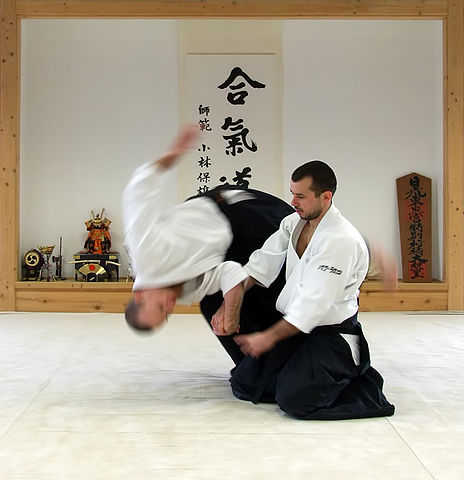
by Luke Archer
Nowadays it’s much more “accepted” to be subjected to psychological or verbal abuse than physical abuse. Due to this social tolerance and the apparent subjective nature of such abuse it can be considerably harder to deal with it or to even imagine that it could subside. Too often, the victims of regular and persistent verbal abuse continue to grin and bear it without having a means to deal with the abuse intelligently and peacefully. Verbal Aikido is simply a communication tool that has proven to be an efficient approach to managing and defusing conflict – and one that can be easily acquired in three straightforward steps.
Through the methods and exercises taught in Verbal Aikido, the practitioner develops a sense of self-control, an assertive style of communication, and the practice of deliberate intention. The clarity to habitually react with deliberate intention in a conflictual situation highlights the difference between letting a situation escalate into a negative outcome, and providing opportunities for it to move towards a constructively positive direction or a balanced outcome.
A brief history and explanation of martial aikido
 If you’re not familiar with martial aikido, you may erroneously think that it is just another way of exchanging punches and kicks, and possibly imagine that Verbal Aikido would then be just a means to joust verbally in order to ‘slay’ your interlocutor. However, once you discover the philosophy and approach to this non-competitive martial art, you will quickly see the differences it has with other forms of ‘combat’. In fact, one of the main principles in aikido is that there is no combat, because it is over as soon as it begins. Another core concept is that aggressiveness is never replied to with aggressiveness. The specific goal that the founder, Morihei Ueshiba, had for the art was that it would enable practitioners to defend themselves while also keeping the attacker from harm! Indeed, you will not find competitions in mainstream aikido; rather ‘seminars’ where the techniques are exchanged between practitioners for mutual benefit.
If you’re not familiar with martial aikido, you may erroneously think that it is just another way of exchanging punches and kicks, and possibly imagine that Verbal Aikido would then be just a means to joust verbally in order to ‘slay’ your interlocutor. However, once you discover the philosophy and approach to this non-competitive martial art, you will quickly see the differences it has with other forms of ‘combat’. In fact, one of the main principles in aikido is that there is no combat, because it is over as soon as it begins. Another core concept is that aggressiveness is never replied to with aggressiveness. The specific goal that the founder, Morihei Ueshiba, had for the art was that it would enable practitioners to defend themselves while also keeping the attacker from harm! Indeed, you will not find competitions in mainstream aikido; rather ‘seminars’ where the techniques are exchanged between practitioners for mutual benefit.
So what does the word ‘aikido’ mean?
You may already be familiar with the use of ‘do’ in other martial arts, for example: Judo, Taekwondo and Jeet Kun Do. In all of these, the do signifies ‘the way of’ or ‘the path to’. Ai is the Japanese for ‘harmonious’ or ‘balancing’, and ki means ‘life spirit’ or ‘energy force’ (e.g. Tai-Chi, Qi-Gong). Ai-ki-do is thus often translated as ‘the way of harmonious spirit’ or ‘the path to balancing energy’
When dealing with attacks we often become conscious of the choices available to us, and we can observe that we have the possibility to decide to enter or not into a conflict… conflict is literally ‘striking together’, just like inflict is ‘striking into’ and afflict is ‘to be struck’. Both physical and verbal aikido enables us to embrace the strikes, explore directions and transform them into pacified outcomes. An Aikido approach follows the same steps necessary for a constructive reconciliation – embrace, explore and ‘exflict’ (i.e. come out of striking).
The philosophy throughout Aikido upholds the clear intentions of:
- Receiving the ‘strike’ without being in ‘conflict’ or striking together (i.e. seeing it as an invitation to dance – try the Inner Smile approach)
- Understanding the direction of the ‘striker’ by following their movement (e.g. the Irimi movement of ‘entering’ or bringing your center closer to the other’s)
- Leading or being implicated in bringing the outcome to a balanced or pacified state for all involved (i.e. Aiki or ‘balanced energy’)
Luke Archer is an an Irish-born teacher trainer and public speaker on communication, conflict management, and pedagogy. Living in France since 1995, he founded Betterfly France, a teaching institute based in Lyon in 2008.
His admiration and understanding of Aikido eventually led him to embark on the adventure that brought to life an “off-the-mat and fun-to-learn approach to managing conflict”. Luke continues to develop the Verbal Aikido approach to transforming conflict through workshops, training as well as the book and blog. He has always worked with a wide range of groups and individuals: from underprivileged children and university students to teachers and CEOs of multinational firms.

